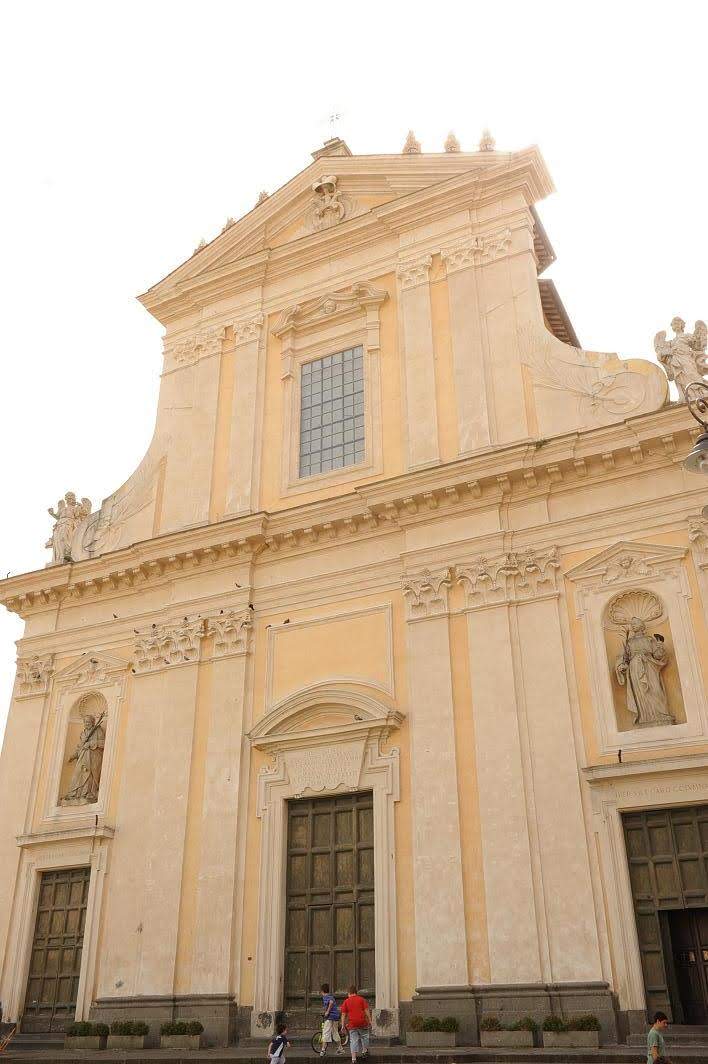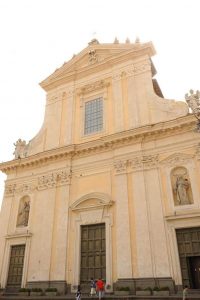The façade is in elegant baroque style carried out between 1652 and 1653.
The lower part of the façade is divided in three by Corinthian pilasters and a 2m high statue in painted peperino overcomes both side portals. The left hand statue shows St. Barnaba holding a palm frond in sign of martyrdom, while on the right St. Lucia of Syracuse is holding a martyr’s palm and a plate with her eyes, as a symbol of her faith. Above the statues, next to the spirals, are two other statues of angels.
The tympanum contains the family’s heraldry crest, a column with a cardinal’s galero on top and six torches in peperino resting on the pediment.
The basilica has a three-nave layout. The side ones are covered by barrel vaults orthogonal to the central nave, which is completed by an overhead barrel vault with lunettes.The six lunettes from the central aisle and the lanterns from the dome supply natural light to the church.
Inside you can see: the altar of the Madonna del Popolo (Madonna of the People) where an image of the Madonna, probably coming from Constantinople, was worshipped; the Martirio di San Bartolomeo (Martyrdom of Saint Bartholomew) by Guercino, alongside the altar bearing the same name; the Martirio di San Barnaba (Martyrdom of Saint Barnaba) attributed to Bartolomeo Gennari, from the school of Guercino; the 18th century baptismal font; the statue of Alessandro Algardi representing Girolamo Colonna placed in a niche above the choir.
In the antechamber of the Sacristy there are some important works such as San Francesco d’Assisi attribuited to Girolamo Muziano (1528-1592) or to Giovan Battista Caracciolo (1578-1635); l’Umanità di Cristo carried out by Cherubino Alberti on a drawing of Michelangelo Buonarroti, and oval paintings on two facing walls representing San Pietro and San Paolo attributed to Guido Reni.
Furthermore, San Rocco (St. Rocco), a copy of the painting conserved in the church of Santa Maria delle Grazie and attributed to Domenichino or to Mattia Farnese (1631-1681). The painting was originally intended for the chapel of St. Rocco, in the district bearing the same name, before it was razed to the ground in 1944.
Other remarkable features are the illusionistic frescoes on the church ceiling, which were achieved by a sotto in su technique and represent the Glory of the Holy Spirit, as well as the choir stalls in walnut that date back to 1747.
In 1697, the Oratory of the Venerabile Arciconfraternita del Gonfalcone (Oratory of the Banner) was built behind the basilica and became the permanent seat of the confraternity. The interiors are covered with many beautiful frescoes.


 Visit Castelli Romani
Visit Castelli Romani 


